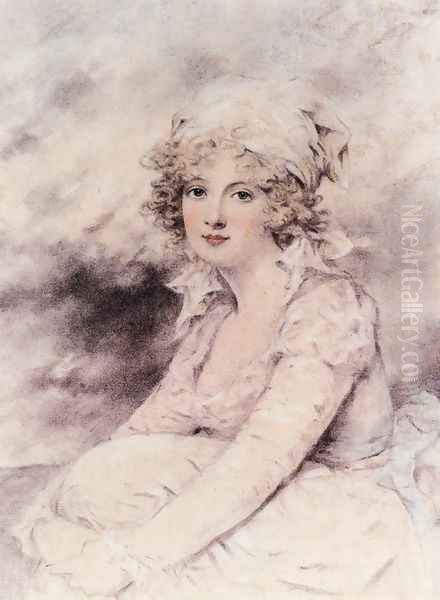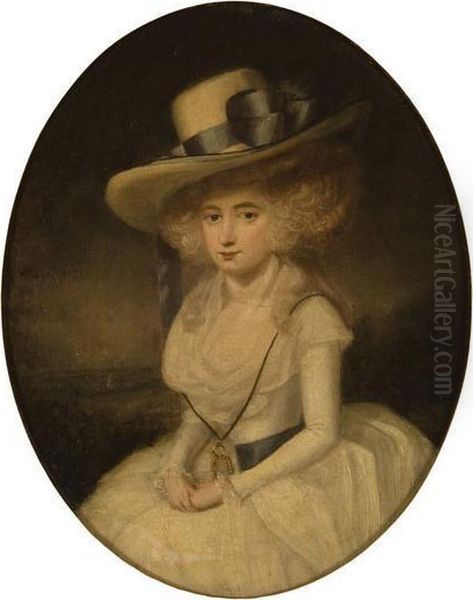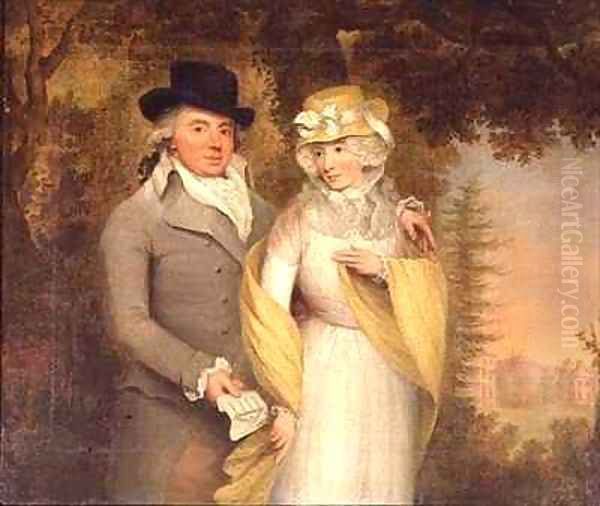
John Downman stands as a significant figure in the landscape of late 18th and early 19th-century British art. Active during a vibrant period for portraiture, he carved a distinct niche for himself with his charming, elegant, and rapidly executed likenesses. Born in 1750 and passing away in 1824, Downman's career spanned a time of great social and artistic change in Britain. He became particularly renowned for his delicate portraits, often created in a combination of watercolour and pencil, capturing the grace and fashion of his era with a light, assured touch that appealed greatly to the aristocracy and society figures of his day.
Early Life and Artistic Formation
John Downman entered the world in 1750 in Ruabon, a town nestled in North Wales. His background was respectable; his father, Francis Downman, was an attorney, providing a stable, professional environment. His mother brought connections reaching higher, being the daughter of Charles Goodsend, who had served as private secretary to King George I. This connection, however distant, perhaps hinted at the circles Downman would eventually move within through his art.
Seeking to pursue an artistic career, Downman made the pivotal move to London in 1769. This was a significant year for the London art world, as the Royal Academy of Arts had recently been established. Downman was among its very first cohort of students, placing him at the heart of the burgeoning British art establishment from the outset. His training was further solidified under the tutelage of Benjamin West, a highly influential American-born painter who became the second President of the Royal Academy and historical painter to King George III. Studying with West provided Downman with a strong foundation and exposure to the highest levels of artistic practice in London.
The Grand Tour: Italian Influence
A formative experience for many artists of the era was the Grand Tour, and Downman was no exception. Between 1773 and 1774 (returning in 1775 according to some accounts), he embarked on a journey to Italy. Crucially, he travelled in the company of Joseph Wright of Derby, a painter celebrated for his dramatic use of light and shadow, particularly in scenes of science and industry, but also a capable portraitist.

Their travels took them through key artistic centres, including Rome and Florence. Exposure to the masterpieces of Italian art, both classical and Renaissance, undoubtedly broadened Downman's artistic horizons. While his style remained distinctly his own, the experience likely refined his sense of composition and grace. The companionship with Wright, an established artist with a unique vision, would also have provided invaluable opportunities for discussion and artistic exchange, influencing his development in ways subtle or direct. This period abroad was a vital interlude before he established his mature career back in Britain.
A Distinctive Style: Speed, Lightness, and Charm
Upon his return to Britain around 1775, John Downman began to establish his professional practice. He did not confine himself solely to London, also working in important centres like Cambridge and Exeter, indicating a demand for his skills beyond the capital. His artistic style quickly became his calling card. It was characterized by a remarkable speed of execution, combined with a bright, luminous quality and a vibrant sense of life.
Downman primarily excelled in portraiture. He developed a highly popular technique involving drawing in pencil or chalk, often black, sometimes combined with stump (a rolled paper tool for blending), and delicately finished with watercolour washes. This method allowed for both accuracy in likeness and a fresh, airy aesthetic. The flesh tones, often subtly applied, contrasted pleasingly with the graphite lines defining features and hair. This technique was particularly suited to capturing the nuances of fabric, fashionable hairstyles, and the delicate complexions favoured in the period.
His portraits, frequently small in scale, were noted for their elegance and refinement. He had a particular talent for depicting women, capturing not just their features but also a sense of their personality and fashionable sensibility. This combination of speed, relatively lower cost compared to large oil portraits, and charming results made his work exceptionally popular among the gentry and aristocracy. Clients could acquire pleasing likenesses without the lengthy sittings required by painters like Sir Joshua Reynolds or Thomas Gainsborough, who dominated the grander scale of oil portraiture.
Flourishing Career and Recognition
Downman's appealing style found a ready market. He worked consistently, building a reputation in London and provincial centres. His ability to produce flattering yet characterful portraits ensured a steady stream of commissions. His work was frequently exhibited at the Royal Academy, keeping his name visible within the art establishment and among potential patrons.

His standing within the artistic community was formally recognized in 1795 when he was elected an Associate of the Royal Academy (ARA). This distinction confirmed his status as a respected professional artist in London. He continued to travel for work, visiting Plymouth in 1806 and undertaking a significant period of work in Exeter between 1807 and 1808. These excursions suggest his reputation extended well beyond London and that patrons in the West Country actively sought his services.
Downman's approach differed from some contemporaries. While artists like George Romney captured a certain classical grandeur, and Sir Thomas Lawrence, a younger contemporary, would bring a new dynamism to portraiture, Downman maintained his focus on intimate, delicate likenesses. His style was perhaps less overtly dramatic than that of Joseph Wright of Derby, his former travel companion, or the intense, sometimes melancholic, mood found in works described as 'Byronist' by artists like Walker (as mentioned in the source material, though the specific Walker is unclear). Downman's strength lay in charm, elegance, and an accessible, pleasing representation of his sitters.
Notable Patrons and Subjects
The success of Downman's style is evident in the calibre of his clientele. He attracted commissions from the highest echelons of society, including members of the British Royal Family. He is known to have painted Queen Charlotte, the consort of King George III, a significant mark of royal favour. His portraits were collected by other royals, further cementing his fashionable status.
Beyond royalty, he depicted numerous figures from the aristocracy and the world of celebrity. Among his famous sitters were the celebrated Duchess of Devonshire, Georgiana Cavendish, a renowned beauty and political hostess. He also captured the likeness of Mrs. Sarah Siddons, the pre-eminent tragic actress of her day. The source material mentions a series of chalk portraits of Siddons, showcasing his ability to work effectively in different but related media to capture the presence of such a commanding figure.
His sitters also included figures like Thomas Williams, whose connection to the prominent abolitionist William Wilberforce suggests Downman moved within circles concerned with significant social and political issues of the time. The commission to paint the family of William Middleton, resulting in the work The Family of William Middleton (1792), demonstrates his capability in handling group portraits, arranging figures harmoniously while maintaining individual likenesses. These commissions underscore his position as a sought-after portraitist for the elite.
Representative Works
Several works stand out as representative of John Downman's style and subject matter:

The Family of William Middleton (1792): This group portrait showcases Downman's skill in composing multiple figures within a domestic setting. It likely displays his characteristic light touch and attention to the details of dress and familial interaction, capturing a moment of genteel family life.
A Lady at Work (1790s): This title suggests an informal, perhaps intimate portrayal of a woman engaged in an activity, possibly needlework or writing. Such works allowed Downman to move beyond formal posing, capturing personality through posture and context, highlighting his ability to create engaging genre-inflected portraits.
A Young Lady (c. 1784): Likely a typical example of his popular single-figure portraits, probably executed in his favoured medium of pencil, stump, and watercolour. Such works would emphasize delicate features, fashionable attire, and the overall charm and elegance that defined his appeal.
The Death of Lucretia: This title indicates a foray into historical or classical subject matter, less common for Downman than pure portraiture but demonstrating ambition. Lucretia's story was a popular theme in art, offering scope for drama and pathos. It would be interesting to see how Downman applied his typically lighter style to such a tragic subject.
Rosalind: This likely refers to the character from Shakespeare's As You Like It. Like The Death of Lucretia, this suggests Downman engaged with literary or theatrical themes, perhaps portraying an actress in the role (like his portraits of Siddons) or creating an imaginative character study, blending portrait conventions with narrative elements.
These works, alongside his numerous portraits of named and unnamed sitters, illustrate the range and consistent appeal of his artistic output. His technique, often involving black chalk and watercolour on paper, was well-suited to creating preparatory studies but also finished works that were valued in their own right. Artists like Hugh Douglas Hamilton and Henry Edridge worked in similar veins, creating small-scale portraits that found commercial success, indicating a broader market trend that Downman expertly navigated. Even miniaturists like Richard Cosway catered to a similar desire for portable, intimate likenesses, though Downman's typical scale was slightly larger.
Contemporaries and Artistic Milieu

John Downman worked during a golden age of British portraiture. He was a contemporary of giants like Sir Joshua Reynolds, the first President of the Royal Academy, known for his grand manner portraits, and Thomas Gainsborough, famed for his fluid brushwork and sensitivity to character, often setting his subjects in landscape backgrounds. George Romney also commanded a large and fashionable clientele, known for his elegant, slightly idealized depictions.
Downman's direct interactions are noted with Benjamin West, his teacher, a major figure in historical painting and portraiture, and Joseph Wright of Derby, his travel companion, whose innovative use of light contrasted with Downman's brighter palette. His documented collaboration or stylistic similarity with Hugh Douglas Hamilton and Henry Edridge in the field of small, commercially successful portraits places him within a specific subset of the market. His portraits of Sarah Siddons connect him to the vibrant theatrical world, also painted by many of his contemporaries, including Gainsborough and Sir Thomas Lawrence. Lawrence, emerging towards the end of Downman's main period of activity, represented the next generation, bringing a Regency flair and dynamism to portraiture. Downman also worked alongside female artists who gained prominence, such as Angelica Kauffman, another founding member of the Royal Academy known for her history paintings and portraits. Downman's career unfolded within this rich and competitive artistic environment.
Later Life and Legacy
In his later years, John Downman moved away from the main centres of his earlier career. He eventually settled back in Wales, in Wrexham, the county town of Denbighshire, not far from his birthplace. It was here that he passed away on December 24, 1824, at the age of 74.
His family life had connections to the West Country, where he had worked periodically. He was married to the daughter of the organist of Exeter Cathedral. They had three daughters. The source material notes that one of his daughters married and subsequently died in Wrexham, perhaps influencing his decision to spend his final years there. It also mentions that other daughters continued to be involved in artistic pursuits, suggesting that creativity may have run in the family.
John Downman left behind a substantial body of work. His distinctive portraits, particularly those in chalk and watercolour, remain highly recognizable. Major institutions, including the National Gallery in London and the British Museum, hold examples of his work, ensuring its accessibility to scholars and the public. His drawings and watercolours offer a charming and intimate glimpse into the society of Georgian England, capturing its personalities and fashions with a unique blend of speed, elegance, and light.
Conclusion
John Downman occupies a specific and important place in British art history. While perhaps not reaching the towering fame of Reynolds or Gainsborough, he excelled in his chosen format, creating portraits that were perfectly attuned to the tastes of his time. His technical proficiency, particularly in combining drawing and watercolour, allowed for a rapid yet refined output that met a clear demand. His work provides a valuable visual record of the faces and fashions of the late Georgian era, rendered with a characteristic charm and lightness. Remembered for his elegant depictions, especially of women, and his popularity with the elite, Downman's legacy is that of a skilled, sensitive, and highly successful portraitist whose works continue to delight.